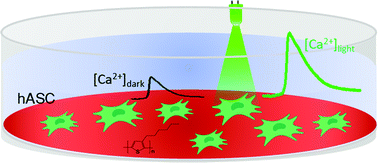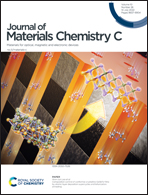Polythiophene-mediated light modulation of membrane potential and calcium signalling in human adipose-derived stem/stromal cells†
Abstract
Recent progress in the fields of regenerative medicine and tissue engineering has been strongly fostered both by the investigation of crucial cues, able to trigger the regeneration of damaged tissues, and by the development of ad hoc functional materials, capable of selectively (re-)activating relevant physiological pathways. In parallel to the successful realization of biochemical cues and the optimization of delivery protocols, the use of biophysical stimuli has been emerging as an alternative, highly effective strategy. Techniques based on electrical, magnetic and mechanical stimulation have been reported to efficiently direct differentiation of stem cells and modulate cell physiology at different developmental stages. In this framework, the use of optical stimulation represents a valuable approach, possibly overcoming current limitations of chemical cues, like limited spatial and temporal resolution and poor control over the extracellular environment. Surprisingly, the effects of light on the physiological properties (light toxicity, cell membrane potential, and cell ionic trafficking) of undifferentiated cells, as well as on their differentiation pathways, were investigated to a very limited extent and rarely quantified in a systematic way. In this work, we aim at clarifying the effects of optical excitation on the physiological behaviour of undifferentiated human adipose-derived stem cells (hASC), cultured on top of a light-sensitive conjugated polymer, region-regular poly-3-hexyl-thiophene (P3HT). Interestingly, we observe statistically significant modulation of the cell membrane potential, as well as noticeable effects on intracellular calcium signalling, triggered by P3HT excitation upon green light stimuli. Possible mechanisms involved in the signal transduction pathways are considered and critically discussed. The capability to modulate the physiological response of hASC upon photoexcitation, in a highly controlled and selective manner, provides a promptly available and non invasive diagnostic tool, thus contributing to the understanding of the complex machinery behind stem cells and material interfaces. Moreover, it may open the route to novel techniques to drive the differentiation path with unprecedented versatility and operational easiness.



 Please wait while we load your content...
Please wait while we load your content...